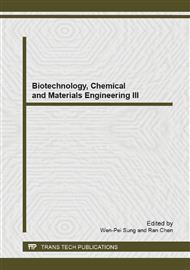p.465
p.471
p.475
p.481
p.485
p.490
p.494
p.498
p.503
Physicochemical Characteristics of Bacteriocin Produced by Pediococcus pentosaceus H6
Abstract:
Lactic acid bacteria H6 was isolated from dried yak jerky by plate dilution method, and using the Listeria monocytogenes as indicator, the Oxford cup method was used to test the bacteriostasis effect. Lactic acid bacteria H6 were identified as Pediococcus pentosaceus by 16S rRNA sequence. The growth curve of Pediococcus pentosaceus H6 was determined by Turbidimetry, and the antibacterial activity of bacteriocin H6 was measured by two fold dilution method and the Oxford cup method. Studying on the thermal stability and pH stability, our results indicated that the barteriocin H6 has better antibacterial effect in acidic conditions or at 100 °C for 90min. The antibacterial spectrum of bacteriocin H6 proved its good inhibitory effect on proliferation of Listeria monocytogenes and other Gram-positive bacteria, and had a certain inhibitory effect on Escherichia coli and other Gram-negative bacteria, showing a broad-spectrum antibacterial property, which demonstrate its great potential in food preservation
Info:
Periodical:
Pages:
485-489
Citation:
Online since:
January 2014
Authors:
Keywords:
Price:
Сopyright:
© 2014 Trans Tech Publications Ltd. All Rights Reserved
Share:
Citation:


